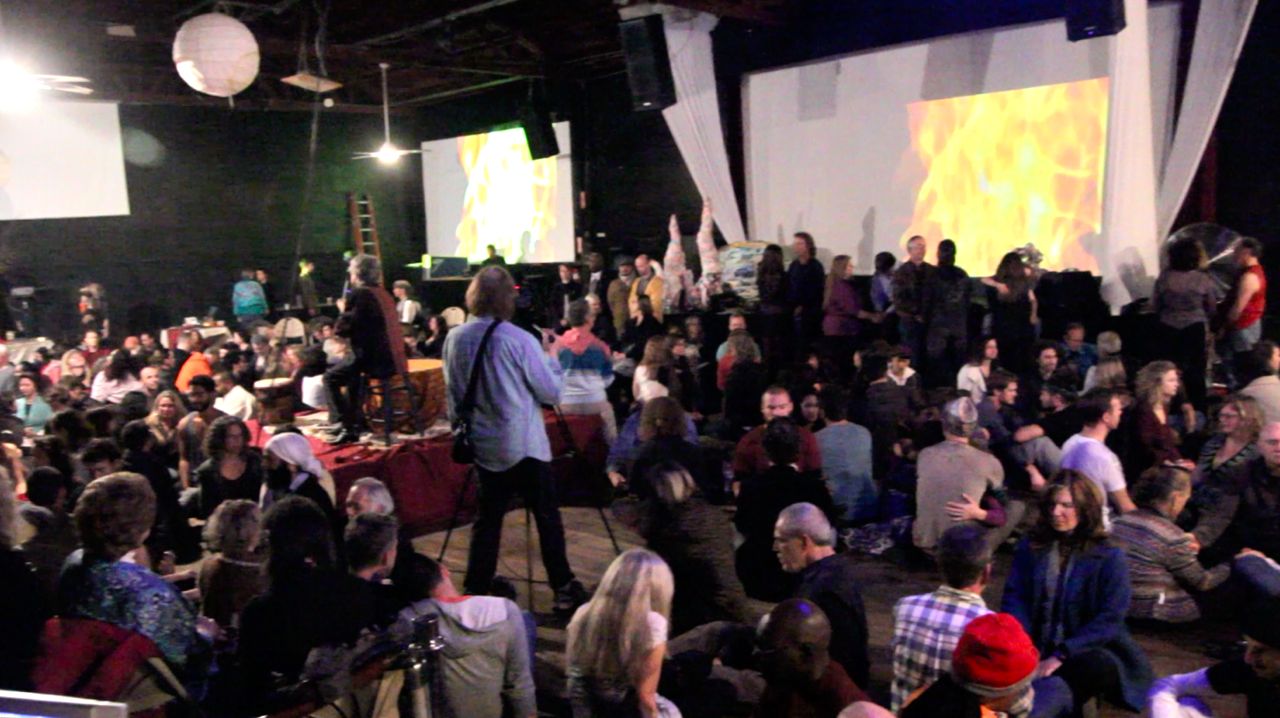The nation is embarked on a review of its soul vis-à-vis racism and white supremacy since the horrible attack on nine members of a black church in Charleston. As well it should be. But there is another act of white supremacy that needs the attention of all and especially Catholics.
It was with very sad hearts that we who respect the Native American peoples learned of Pope Francis’ decision to canonize Father Junipero Serra (1713-1784) during the papal visit to the United States in Fall, 2015.
Serra is the Franciscan missionary who oversaw the colonial system of missions in California. The news of his prospective canonization is sad for what it says about Church ignorance—after all these hundreds of years—of Native American accomplishments; it is also sad for what it reminds us about the history of Christian missionizing. A Native American from California recently wrote me that “by virtue of this canonization of a conqueror, the pope has declared war on Native Peoples, globally.”
As America is waking up to the pain that the Confederate Flag represents especially to Black Southerners, it must also wake up to the fact that the missions are not pretty postcard places nicely painted in white. They were places of enforced labor and whippings where white supremacy ruled against indigenous peoples in the name of church and empire. What the Confederate Flag means to the South is what the California missions mean to the indigenous peoples there. Ask their descendants! Read three-time Pulitzer prize-winning author Elias Castillo’s, A Cross of Thorns: The Enslavement of California’s Indians by the Spanish Missions to get the true story.
Serra is Colonizer-in-Chief; he is a racist; he is a white supremacist. Why canonize him in 2015? Native peoples are furious and for very good reason. Among the California tribes alone who have objected are the following: the Xolon Salinan Tribe; the Iipay Nation of Santa Ysabel; Cupeno; Miwok; Cahuilla; Kizh Gabrieleno; Pomo; Ohlone; Kumeyeaa; Chumash. I am told that many casino tribes object also but do not want to be named lest their pious Catholic gamblers would no longer frequent their casinos. It is appalling that in 2015 so-called theologians on the East coast, all white, do not bother to bring in Native Americans from California to tell the truth of what Serra & Co. did to their ancestors and the price they have paid for centuries for this abuse in the name of Empire and Church.
It is particularly sad that the first American pope ever, one who has caught the attention of millions for his efforts to cleanse the church of its sins and society of its “narcissism” and social and economic inequities, and who has actively sought the perspectives of the faithful, would be so blind to the history of indigenous peoples on two continents, and deaf to the protests of indigenous and non-indigenous Christians alike. And it is sad that as many nations and peoples applaud the pope’s encyclical on Eco-theology and Climate Change that still another stake would be driven into the indigenous legacy of respect for nature that is so central to their spiritual tradition and to the survival of the planet as we know it today.
This is a severe blow to the hopes of people looking to a reformed papacy and a reforming pope. Granted, Pope Francis is only human like the rest of us and humans err—as he says, he himself is a sinner. And this decision is a grave sin indeed.
Serra’s theology was retrograde even in his own day and by standards even of his own time—saying nothing of today. How remarkable it is that Pope Francis is on the cusp of canonizing Archbishop Romero of El Salvador who stood up to the extreme right-wing militias of his country to stand on the behalf of the poor, and is thereby choosing to rehabilitate liberation theology -- but the same Pope is tone deaf to the colonial and “enslavement” theology that motivated Serra.
What was Serra’s theology? When Serra left Spain for the Americas while in his mid-thirties, he mused about his parents “preparing themselves for that happy death which of all the things of life is our principal concern.” Unfortunately that was his driving ideology as a missionary to the Indians as well. In January, 1780, thirty-two years after arriving in the Americas, Serra writes about how to treat two Indian leaders who had rebelled against the missions, and displays his already familiar theology:
“I would not feel sorry no matter what punishment they gave them, if they would commute it to prison for life, or in the stocks every day, since then it would be easier for them to die well. Do you think it possible that if they kept them prisoners for a time, and by means of interpreters explained to them about the life to come and its eternal duration, and if we prayed to God for them—might we not persuade them to repent and win them over to a better life? You could impress on them that the only reason they were still alive is because of our affection for them, and the trouble we took to save their lives.”
This is language of the oppressor writ large. Serra urged his friars to baptize the Indians in prison and give them crucifixes and rosaries and dress them in tunics of white cotton cloth “in which they would die and be buried,” thus preparing them it seems for “eternal life.” Actually, their lives were saved not by Serra but by the military governor who commuted their death sentence to hard labor.
According to Spanish law, every mission was to be temporary and within ten years of its founding each was to be handed over to Christian Indians who were also to take over as governors of the land and mission. But Serra (who never really learned the native peoples’ languages) objected that the Indians were incompetent to govern themselves and needed to be supervised and punished by the friars…even though the Indians had dwelt on the land for thousands of years and knew far more about raising crops indigenous to the land than did the Spaniards, and also had developed a culture based on sharing and co-operation, not power-over.
Serra also objected to being denied his practice of whipping the Indians. Wanting to continue this practice, he wrote to the military governor Felipe de Neve that there “may have been some inequalities and excesses on the part of some fathers and that we are all exposed to err in that regard.”
Nevertheless the end apparently justifies the means because, as he puts it “when we came there, we did not find even a single Christian, that we have engendered them all in Christ, that we, every one of us, came here for the single purpose of doing them good and for their eternal salvation, and I feel sure that everyone knows that we love them.”
Really? Whipping people; taking their land; forbidding their rituals; ending their languages; locking them up in colonial church properties from which they were forbidden to leave and visit relatives and friends; destroying their culture and subsistence by hunting and gathering; introducing diseases; and bringing in soldiers who frequently raped the native women; all in the name of the Spanish “king and lord” and for the sake of the Empire—this is loving them? This is “engendering them all in Christ?” This is not love. Nor is it justice. It is colonialism writ large. And with God and Jesus and Imperial Christianity legitimizing it.
Also, Serra himself was big on beating his body with whips and piercings. Maybe his masochism rendered his sadism less of an issue: “Love others as you love yourself” as someone said. But why endorse such a person’s theology and spirituality at this time? Why, Why, Why canonize someone in 2015 who stands for such bad theology and bad intercultural values, utterly lacking the respect and humility that lie at the foundation of interfaith?
This canonization is a scandal. People should be flooding the Vatican with letters of objection. It is not Pope Francis at his best. It is not Christianity at its best; it conjures up the worst shadows (of which there are so many) in the history of the Imperial Church, a church many hoped we had left behind. With the teachings of Vatican II and the powerful teachings and witness of Archbishop Romero in the 1980s, surely we have come farther than this!
This disastrous decision puts wind in the sails of those who have learned nothing from the dark days of colonialism in the name of God and Empire, at a time when indigenous peoples around the world are facing the destruction of their lands and cultures at the hands of corporate and government militia. The system Serra set up was paternalism at its worst: it treated native peoples as helpless children, and reinforced an other-worldly religion.
One Franciscan historian comments on Serra and the epidemics that the Europeans introduced to the indigenous peoples: “Death might wreak havoc among his hard-won neophytes, but he found consolation in his sorrow, for he had prepared them for a future life which, his religious convictions assured him, was worth infinitely more than the life they were leaving and the pain of parting.” At a mission in Santa Clara there was a great epidemic in May 1777 but Serra’s companion friar Palou writes of how “the fathers were able to perform a great many baptisms by simply going through the villages. In this way they succeeded in sending a great many children (who died almost as soon as they were baptized) to heaven.”
It seems that Serra and his companion friars never wavered in their compulsion to reduce Christianity to a promise of life-after-death. Too bad that they missed their Master’s teaching of love and life fully lived here and now, the promise of the kingdom/queendom of God on earth, a place where justice flowed like a river and the prophet pictured it. One critical commentator summarizes Serra’s mission this way: “Clearly, if sainthood means self sacrificing devotion to harvesting pagan souls for the kingdom of god in heaven, then Junipero Serra deserves to become a saint.”
If not, one asks anew: WHY is the pope making so profound a mistake? Why create a patron saint for colonizers and racists in the year 2015? Why not instead take the occasion of his visit to the United States to do an about-face and canonize those thousands of native peoples who died at the hands of misguided, badly theologically trained, servants of the Empire?
Indeed, why not get on one’s knees in humble confession and ask the Native Peoples for forgiveness?
The Pope’s New Encyclical vs. the Canonization of Serra
The pope's new encyclical, wise as it is about climate change, completely contradicts the misguided effort to canonize Serra a saint. Here are his words with my response in brackets:
number 145: "The disappearance of a culture can be just as serious, or even more serious, than the disappearance of a species of plant or animal. The imposition of a dominant lifestyle linked to a single form of production can be just as harmful as the altering of ecosystems. [Was not Serra's mission system a device to replace one ancient culture with another imperial one? Didn't it contribute to the disappearance of a culture? Why canonize him then?]
- “In this sense, it is essential to show special care for indigenous communities and their cultural traditions. They are not merely one minority among others, but should be the principal dialogue partners, especially when large projects affecting their land are proposed.” [Where then is the dialog with these communities and “principal dialogue partners” regarding the canonization of Serra happening?]
“For them, land is not a commodity but rather a gift from God and from their ancestors who rest here, a sacred space with which they need to interact if they are to maintain their identity and values. When they remain on their land, they themselves care for it best”. [Then why canonize someone who made it a policy to take them from their land and had no respect for how they lived on the land and cared for it for centuries before the Europeans invaded?]
“Nevertheless, in various parts of the world, pressure is being put on them to abandon their homelands to make room for agricultural or mining projects which are undertaken without regard for the degradation of nature and culture.” [Before the mining companies pressured them to abandon their homelands and degrade their culture the church did the same--why canonize the man, Serra, who symbolizes this very act of degrading a culture in the name of a foreign ideology? He who is a “colonizer-in-chief”?]
- “The principle of the common good immediately becomes, logically and inevitably, a summons to solidarity and a preferential option for the poorest of our brothers and sisters.....It demands before all else an appreciation of immense dignity of the poor in the light of our deepest convictions as believers.” [Then why ignore the agonizing and loud cries of the indigenous poor AGAINST the canonization of Serra?]
If you share these feelings of grief and outrage at the upcoming canonization of Junipero Serra, let your voice be heard! Please sign this petition…and spread the word so others can do so also. Thank you.
http://petitions.moveon.org/sign/urge-pope-francis-to?mailing_id=29425&source=s.icn.em.cr&r_by=492022
____________________________________________________________
[1] Junipero Serra, letter to Francesch Serra, Cadiz, 20 August 1749, Antonine Tibesar, O.F.M., ed, Writings of Junipero Serra (Washington, DC: Academy of American Franciscan History, 1955) vol. 1, p. 5.
[2] Serra, letter to Fermin de Lasuen, Monterey, 12 January 1780, Ibid., vol 3, p. 424f.
[3] Francis Florian Guest, O.F.M., “Cultural Perspectives on California Mission Life, “ Southern California Quarterly, Historical Society of Southern California, Spring 1983, p. 31.
[4] Serra, letter to governor Neve, Monterey, 7 January 1780, Writings of Junipero Serra, vol. 3, pp. 413-15.
[5] Finbar Kenneally, O.F.M. and Mathias Kiemen, O.F.M., Introduction to Writings of Junipero Serra, op. cit., vol. 4, p. xvi.
[6] Francisco Palou, Life of Junipero Serra, C. S. Williams, transl. (Pasadena: G. W. James, 1913), p. 213.
[7] Daniel Fogel, Junipero Serra, the Vatican, and Enslavement Theology (San Francisco: ISM Press, 1988), p. 81. The author does an excellent job of presenting the facts and realities of the Serra story from primary sources and I am indebted to him for the citations presented in this article.
______________________________________________________________
Matthew Fox is a theologian and Episcopal priest who was a Dominican friar for 34 years. He was expelled from the order by Cardinal Ratzinger for, among other things, "working too closely with Native Americans" and supporting women’s, gay, and indigenous rights. His 32 books have been translated into 58 languages and include Letters to Pope Francis, Original Blessing, A Spirituality Named Compassion, The Reinvention of Work, The Pope's War and most recently Meister Eckhart: A Mystic-Warrior For Our Time. Connect with him at his website (http://9f3.fb6.myftpupload.com), Facebook page (https://www.facebook.com/Rev.Dr.MatthewFox) and Twitter feed (@FCSCreationSpir).




 The driving force behind the Beguine movement was an experiential spirituality that embodied the compassion of Christ and sought both to live in contemplation and in compassionate service. Far from the hierarchical religion of the day, Beguines lived a spiritual life that was both humbling and empowering in its experience of unity with God. God was experienced as much as Mother as Father and as much as Mystery as Known.
The driving force behind the Beguine movement was an experiential spirituality that embodied the compassion of Christ and sought both to live in contemplation and in compassionate service. Far from the hierarchical religion of the day, Beguines lived a spiritual life that was both humbling and empowering in its experience of unity with God. God was experienced as much as Mother as Father and as much as Mystery as Known.

 Just last month, Greystone Press released an eloquent testament to the shattering impact of childhood sexual abuse, and the power of truth-speaking in the healing process, in
Just last month, Greystone Press released an eloquent testament to the shattering impact of childhood sexual abuse, and the power of truth-speaking in the healing process, in 
 it was our first Mass in Oakland in several years.
it was our first Mass in Oakland in several years.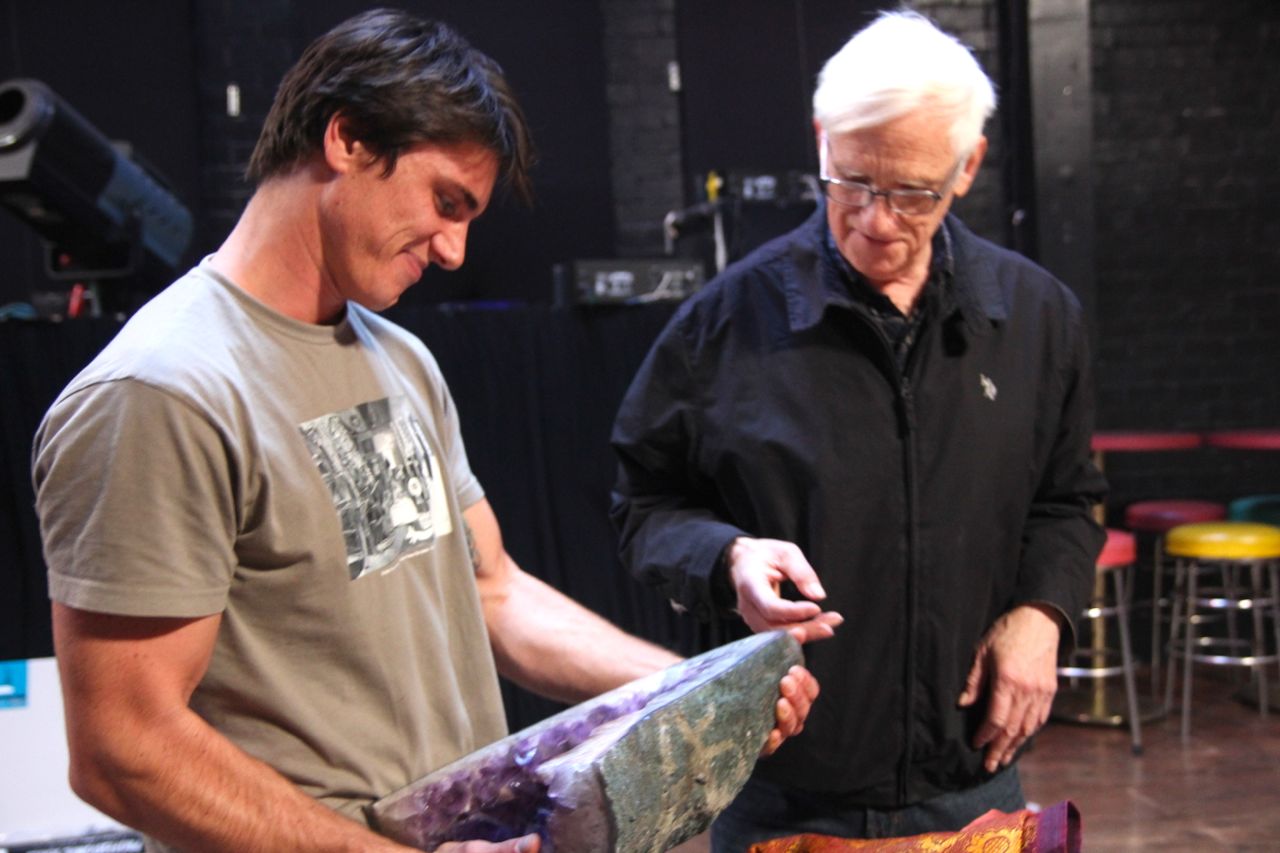 But Dec 1 was a whole new beginning with a new leader—Skylar Wilson--and a new generation taking charge, with the support of Nicole Porcaro and Matthew Fox. The theme was “The Celebration of the Body.”
But Dec 1 was a whole new beginning with a new leader—Skylar Wilson--and a new generation taking charge, with the support of Nicole Porcaro and Matthew Fox. The theme was “The Celebration of the Body.” The location was Kimball's, a club in downtown Oakland in the Jack London Square district and the club manager and the club owner were both impressed with the event. A great entrance field and four fine altars were put together by volunteer teams organized by Rose Elizondo, who also directs the Yellawe Program in Oakland.
The location was Kimball's, a club in downtown Oakland in the Jack London Square district and the club manager and the club owner were both impressed with the event. A great entrance field and four fine altars were put together by volunteer teams organized by Rose Elizondo, who also directs the Yellawe Program in Oakland.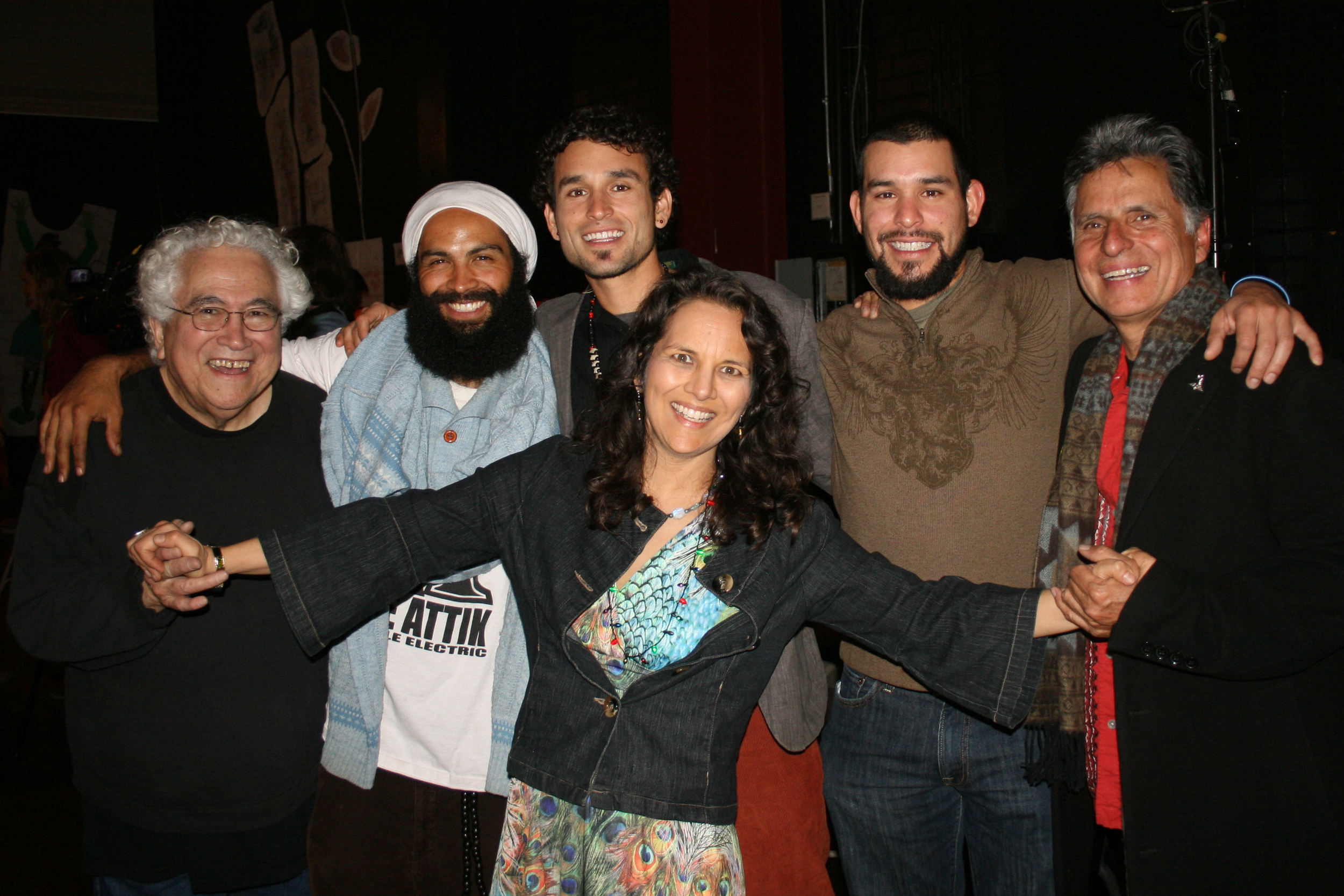 One altar was a stunning mandala of flowers and branches; another an interactive black light space where people were invited to
One altar was a stunning mandala of flowers and branches; another an interactive black light space where people were invited to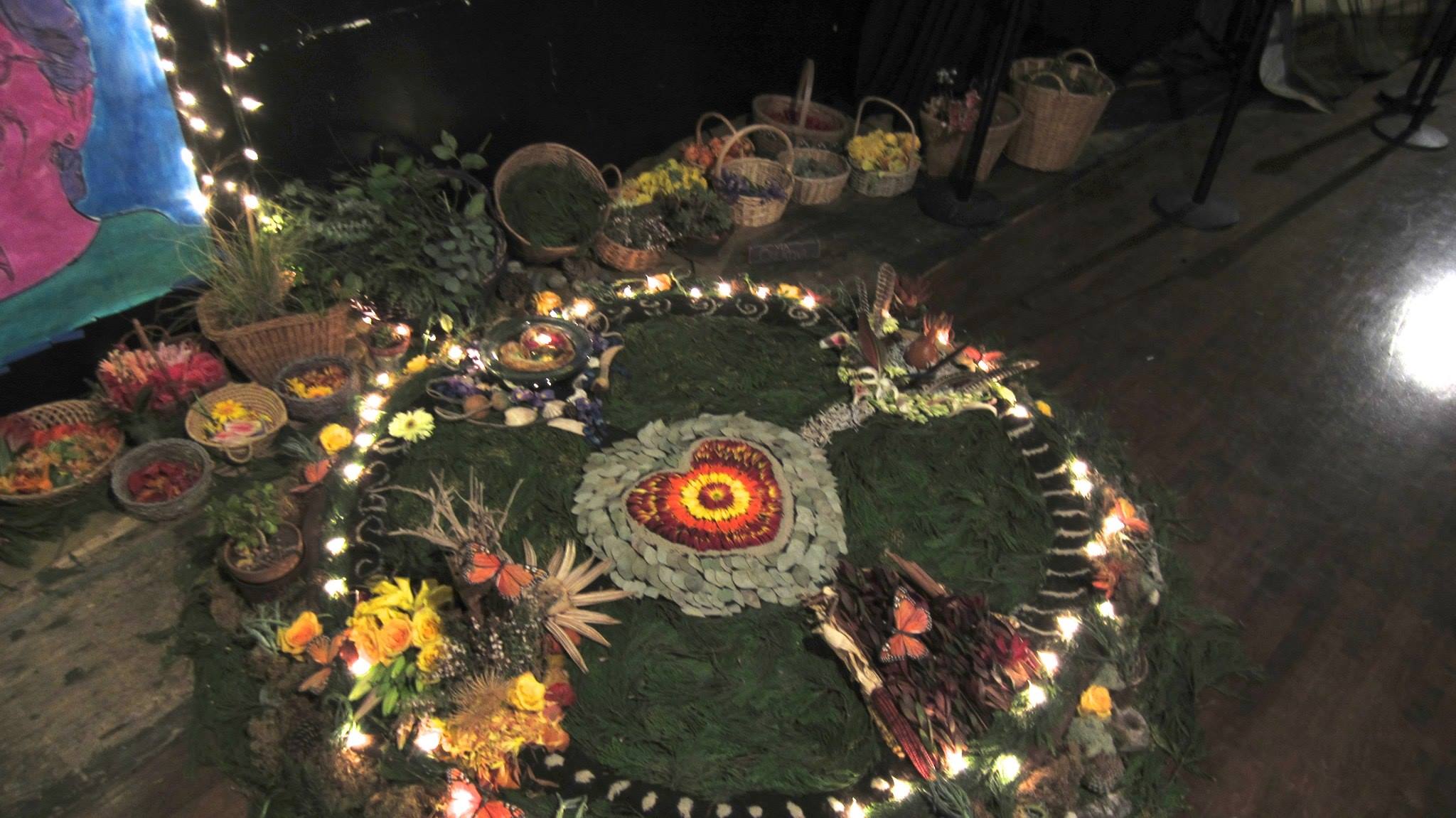 write messages to their bodies. Tom Stang (brother to Sister Dorothy Stang who was martyred in the Amazon for defending the peasants and rainforest there), was in attendance with his wife Darnel... Sister Dorothy, a graduate of the University of Creation Spirituality, had often attended the TCM during her days in the school.
write messages to their bodies. Tom Stang (brother to Sister Dorothy Stang who was martyred in the Amazon for defending the peasants and rainforest there), was in attendance with his wife Darnel... Sister Dorothy, a graduate of the University of Creation Spirituality, had often attended the TCM during her days in the school.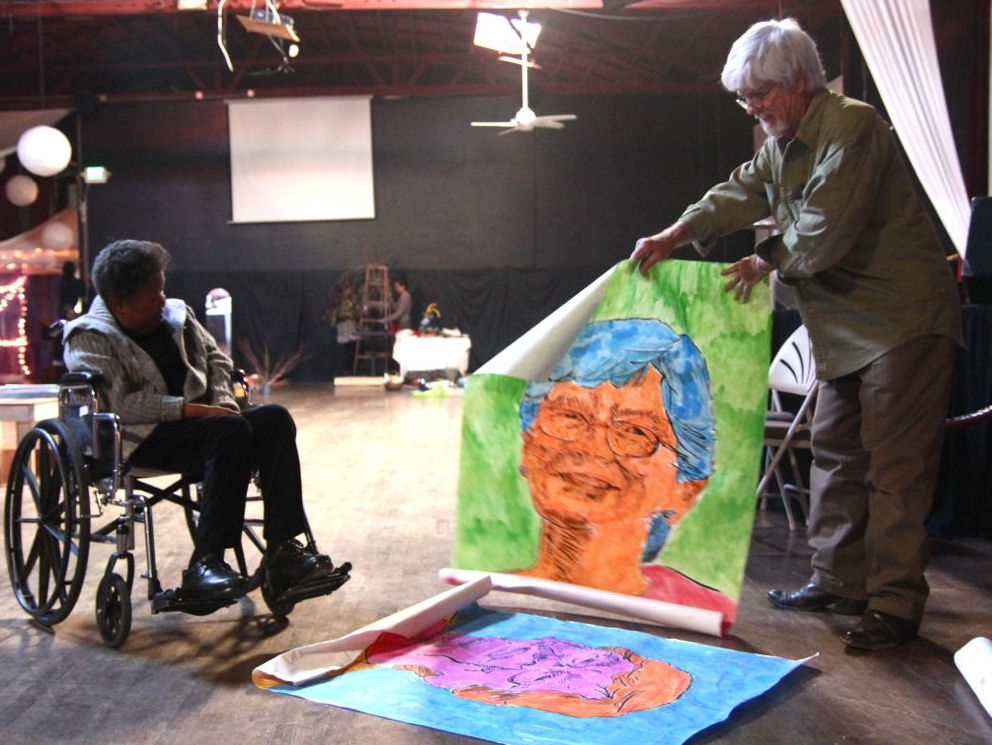 ural Artists Ernesto Olmos and Francisco Franco brought beautiful pieces to display: Ernesto brought his painting of “Madre Tonantzin,” and Francisco actually painted portions of his mural of “The Unveiling—the Birth of Creation” while people were ent
ural Artists Ernesto Olmos and Francisco Franco brought beautiful pieces to display: Ernesto brought his painting of “Madre Tonantzin,” and Francisco actually painted portions of his mural of “The Unveiling—the Birth of Creation” while people were ent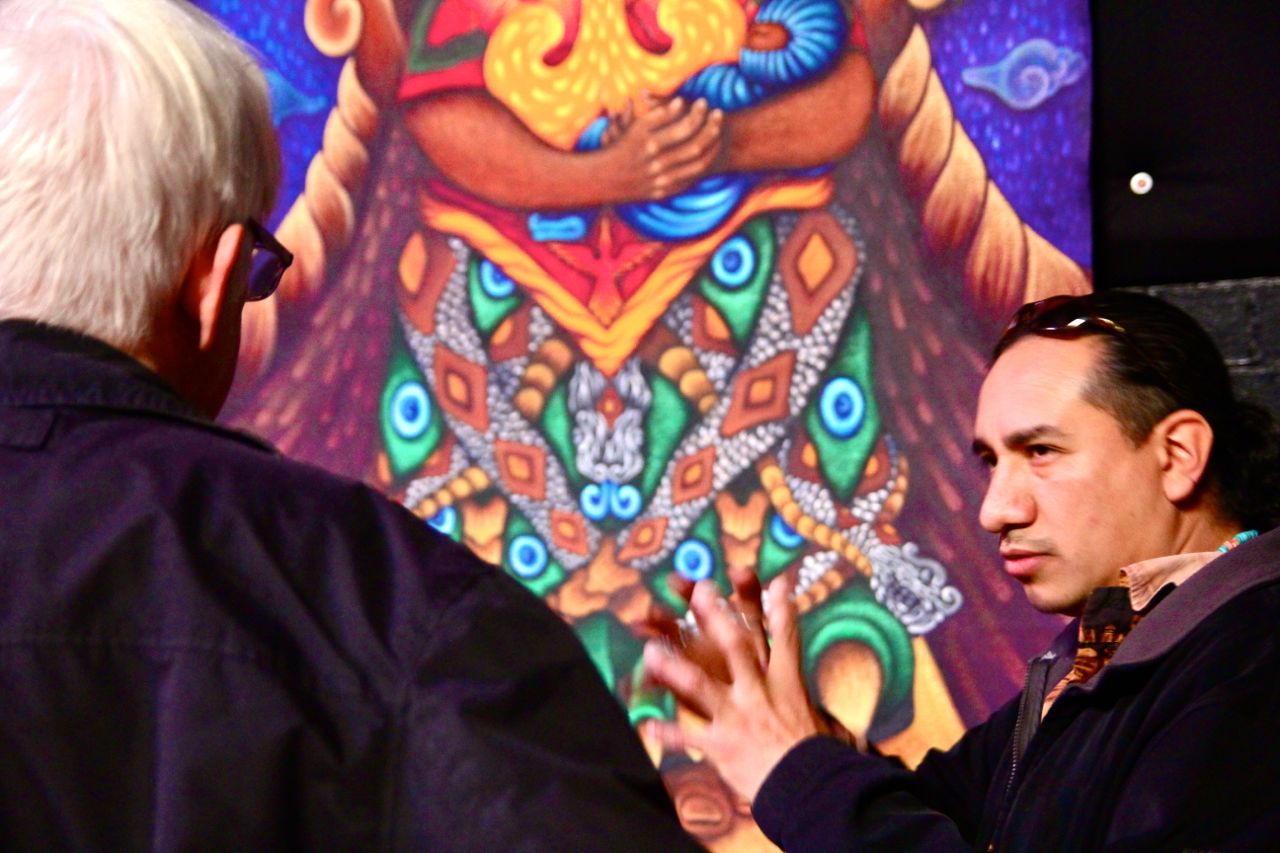 ering.
ering.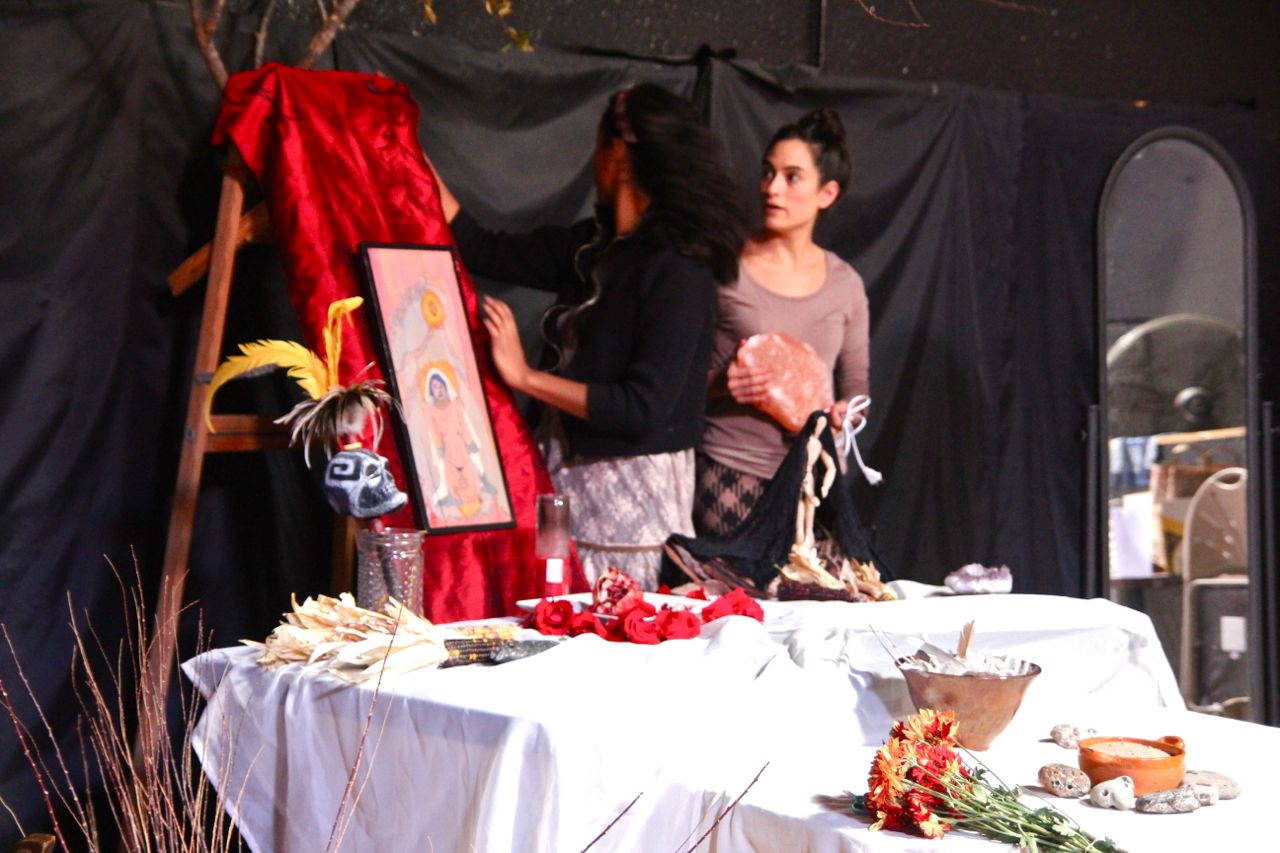 lah. VJ Carol Luna sang a Hildegard song during communion to the accompaniment of Tibetan singing bowls.
lah. VJ Carol Luna sang a Hildegard song during communion to the accompaniment of Tibetan singing bowls. Ziegler prayed at the table prayers for an expansion of human and religious outreach.
Ziegler prayed at the table prayers for an expansion of human and religious outreach.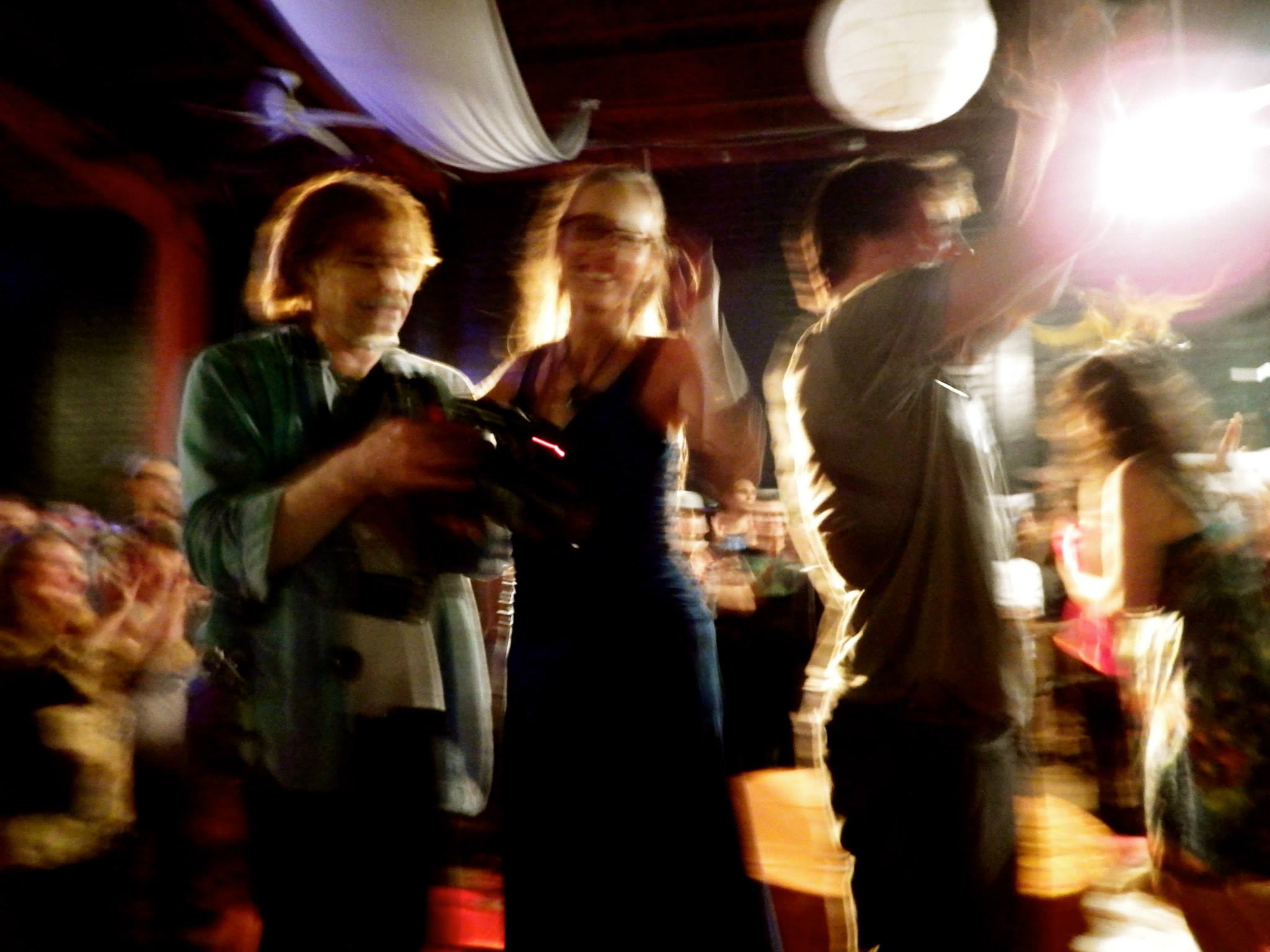 and rap is their kind of language!
and rap is their kind of language!